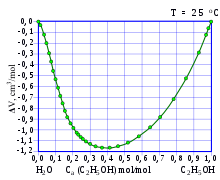Molar volume
The molar volume, symbol Vm,[1] or is the volume occupied divided by the amount of substance (of a chemical element or chemical compound) at a given temperature and pressure. It is equal to the molar mass (M) divided by the mass density (ρ). It has the SI unit cubic metres per mole (m3/mol),[1] although it is typically more practical to use the units cubic decimetres per mole (dm3/mol) for gases and cubic centimetres per mole (cm3/mol) for liquids and solids.
Definition

The molar volume of a substance is defined as its molar mass divided by its density:
- .
For an ideal mixture containing N components, the molar volume is the weighted sum of the molar volumes of its individual components. For a real mixture the molar volume cannot be calculated without knowing the density:
- .
There are many liquid–liquid mixtures, for instance mixing pure ethanol and pure water, which may experience contraction or expansion upon mixing. This effect is called "excess volume".
Ideal gases
For ideal gases, the molar volume is given by the ideal gas equation; this is a good approximation for many common gases at standard temperature and pressure. The ideal gas equation can be rearranged to give an expression for the molar volume of an ideal gas:
Hence, for a given temperature and pressure, the molar volume is the same for all ideal gases and is based on the gas constant: R = 8.31446261815324 m3⋅Pa⋅K−1⋅mol−1, or about 8.20573660809596×10−5 m3⋅atm⋅K−1⋅mol−1.
The molar volume of an ideal gas at 100 kPa (1 bar) is
- 0.022710954641485... m3/mol at 0 °C,
- 0.024789570296023... m3/mol at 25 °C.
The molar volume of an ideal gas at 1 atmosphere of pressure is
- 0.022413969545014... m3/mol at 0 °C,
- 0.024465403697038... m3/mol at 25 °C.
Crystalline solids
For crystalline solids, the molar volume can be measured by X-ray crystallography. The unit cell volume (Vcell) may be calculated from the unit cell parameters, whose determination is the first step in an X-ray crystallography experiment (the calculation is performed automatically by the structure determination software). This is related to the molar volume by
where NA is the Avogadro constant and Z is the number of formula units in the unit cell. The result is normally reported as the "crystallographic density".
Molar volume of silicon
Silicon is routinely made for the electronics industry, and the measurement of the molar volume of silicon, both by X-ray crystallography and by the ratio of molar mass to mass density, has attracted much attention since the pioneering work at NIST by Deslattes et al. (1974).[2] The interest stems from that accurate measurements of the unit cell volume, atomic weight and mass density of a pure crystalline solid provide a direct determination of the Avogadro constant.[3]
The CODATA recommended value for the molar volume of silicon is 1.205883199(60)×10−5 m3⋅mol−1, with a relative standard uncertainty of 4.9×10−8.[4]
See also
References
- International Union of Pure and Applied Chemistry (1993). Quantities, Units and Symbols in Physical Chemistry, 2nd edition, Oxford: Blackwell Science. ISBN 0-632-03583-8. p. 41. Electronic version.
- Deslattes, R. D.; Henins, A.; Bowman, H. A.; Schoonover, R. M.; Carroll, C. L.; Barnes, I. L.; Machlan, L. A.; Moore, L. J.; Shields, W. R. (1974). "Determination of the Avogadro Constant". Phys. Rev. Lett. 33 (8): 463–66. Bibcode:1974PhRvL..33..463D. doi:10.1103/PhysRevLett.33.463.
- Mohr, Peter J.; Taylor, Barry N. (1999). "CODATA recommended values of the fundamental physical constants: 1998" (PDF). Journal of Physical and Chemical Reference Data. 28 (6): 1713–1852. Bibcode:1999JPCRD..28.1713M. doi:10.1063/1.556049. Archived from the original (PDF) on 2017-10-01.
- "2018 CODATA Value: molar volume of silicon". The NIST Reference on Constants, Units, and Uncertainty. NIST. 20 May 2019. Retrieved 2019-06-23.